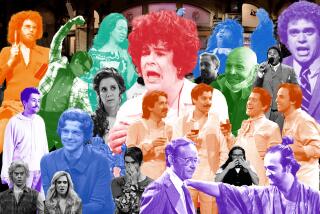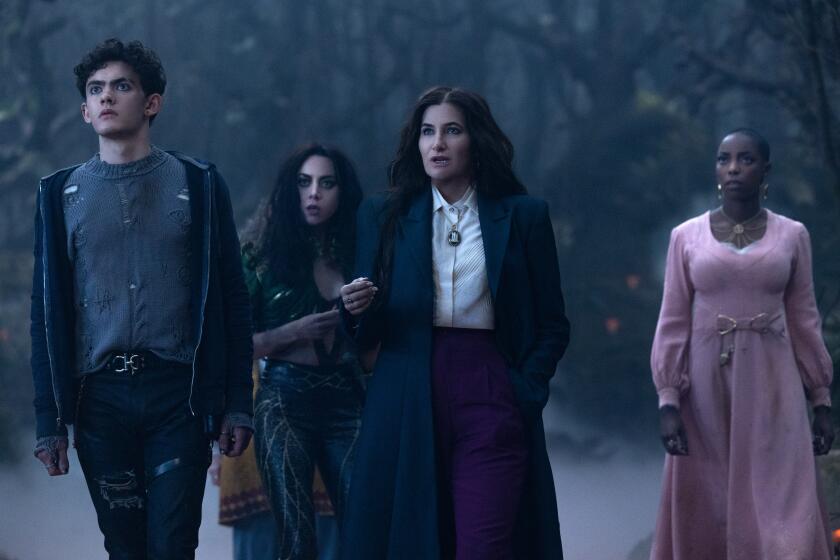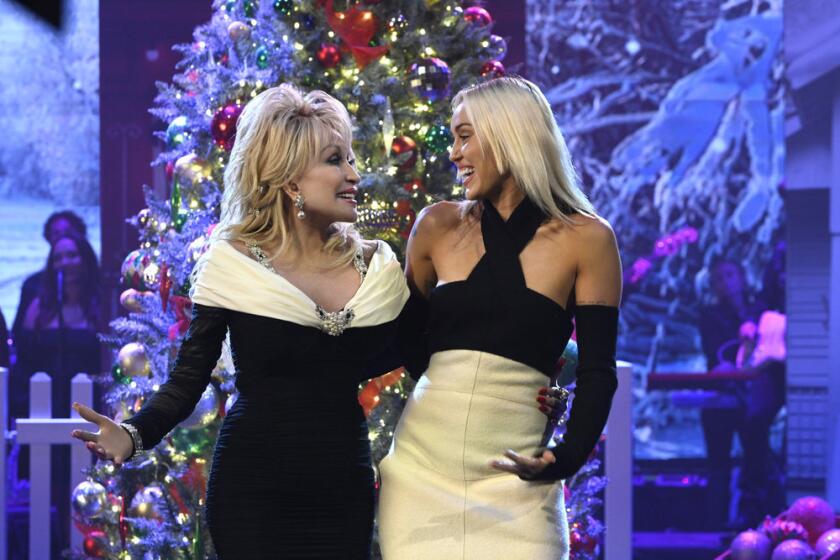An Idea in Chorus With Hollywood
The Los Angeles Master Chorale has been leading a double life.
It’s not just the city’s premier choral organization and frequent collaborator with the L.A. Philharmonic, it’s fast becoming Hollywood’s house choir, having sung in nearly two dozen movies over the past decade (including such hits as “Twister,” “Waterworld,” “Independence Day” and “Air Force One”).
For tonight’s final concert of its 36th season, the Master Chorale revisits six decades of movie history with an unusual and challenging collection of choral music written for movies, from Sergei Prokofiev’s “Alexander Nevsky” in 1938 to Jerry Goldsmith’s “First Knight” in 1995. It’s an ambitious program, according to Fullerton composer J.A.C. Redford, who is producing the concert for the Master Chorale.
“A lot of people think that music for movies, because it has a more straightforward emotional impact, must be shallow,” he says. “This is musically difficult. It’s good material, and it’s going to require all of the elements that you bring to good concert music: the phrasing, the attention to detail, the balance in the orchestra and chorus, all of those things.”
Redford, while best known for his film and TV music (“The Trip to Bountiful,” “St. Elsewhere”), has also written for the concert hall, including a choral symphony and a Christmas cantata.
“I love the combination of choir and orchestra,” Redford says. “I love the drama that can be created with those forces working together, or against each other.” In film music, he notes, “a choir can, in the simplest sense, bring another color into the composer’s palette. The addition of a text makes it more complicated, because text brings a cognitive element to the material. Then it’s no longer just a color, but it’s actually making a comment on something.”
In preparing the program, Redford wanted choral sequences from great composers of the past and present. Complicating his task was the limited availability of scores for public performance (long a problem with movie music, most of which is owned by the studios or indifferent publishers).
The potpourri includes Hungarian composer Miklos Rozsa’s setting of “The Lord’s Prayer” from “King of Kings” (1961), John Williams’ celebratory “Exsultate Justi” from the Steven Spielberg war film “Empire of the Sun” (1987) and Patrick Doyle’s “Non Nobis Domine” from “Henry V” (1989). Three pieces from Italian composer Ennio Morricone’s score for “The Mission” (1986), which combined liturgical music with the indigenous flute-and-percussion sounds of the film’s 18th century South American locale, are also on the program. One notable non-film work will be performed: excerpts from the Mozart “Requiem,” which figured prominently in the climax of the Oscar-winning 1984 film “Amadeus.”
The 120-voice Master Chorale will by joined by the 75-piece Sinfonia Orchestra for most of the concert. The program’s sole a cappella piece will be a new, six-minute arrangement of two classic movie tunes by veteran composer David Raksin: His famous 1944 “Laura,” with its Johnny Mercer lyric, and “The Bad and the Beautiful,” from the 1952 backstage-Hollywood movie, with words by Dory Previn. The arrangement was written by Gene Puerling, of the famed ‘50s vocal group the Hi-Los.
*
When the concept was floated last season, says the chorale’s music director, Paul Salamunovich, “it seemed like a fun idea”--especially since he has sung in more than 100 films, starting with “Joan of Arc,” starring Ingrid Bergman, in 1948.
Salamunovich was part of the chorus in the original 1962 recording of the work scheduled to open tonight’s concert: the overture from “How the West Was Won” by composer Alfred Newman and his longtime choral director, Ken Darby. The work incorporates such traditional American folk material as “Shenandoah” and “I’m Bound for the Promised Land.”
The use of voices in movie music dates at least to the early 1930s, according to film historian Rudy Behlmer, author of “Memo From David O. Selznick” and “Behind the Scenes: The Making of . . . .”
Voices added to the ambience of ‘50s ancient-civilization epics like “Land of the Pharaohs” and “The Egyptian,” “placing us in the period feeling of an archaic world,” Behlmer says. They evoked a nostalgic feeling in movies like “Gone With the Wind,” in which composer Max Steiner had a choir hum “Dixie” to shots of the antebellum South at the start of the film. And they were often used in pictures with religious subjects, like “Quo Vadis” or “The Robe.”
Mostly, however, these were choirs singing “ooohs” and “aaahs.” Occasionally composers set texts, adapted songs or simply created their own words. For 1937’s “Lost Horizon,” Behlmer says, composer Dimitri Tiomkin helped establish a mystical atmosphere with a choir serenely singing pseudo-Tibetan in the background at Shangri-La. Fantasies and pirate movies (“The Thief of Bagdad” and “The Sea Hawk,” from 1940, for example) also benefited from choral elements. “And, particularly in pictures from the golden age, choruses often provided an inspirational, surging finale,” he says.
Today’s composers use voices in more subtle ways. Jerry Goldsmith is probably the most prominent of contemporary composers who make frequent use of choral elements in film scores. He won an Emmy for “QB VII,” a Holocaust-themed miniseries in which he wrote settings for the Kaddish (the traditional Hebrew mourners’ prayer): A choir variously whispered it, spoke it and sung it to suggest the suffering and death of Jews in the concentration camps.
He won an Oscar for “The Omen,” a thriller about the antichrist in which, he explains, he “very deliberately took the Mass and twisted it around.” The Latin text--which prominently featured the phrase “Ave Satani” (Hail Satan)--was meant to create an unsettling mood that tapped into moviegoers’ deep-seated feelings about heaven and hell.
“In the case of using wordless chorus, which I’ve done in other pictures, I think it’s just an added color,” he says, citing women’s and children’s voices in the thriller “Poltergeist” and mixed choir to convey the ancient-Egyptian setting of the opening of last year’s “The Mummy.”
For the climactic battle sequence of the Arthur-and-Lancelot movie “First Knight”--which the Master Chorale sang in the film and will perform tonight--director Jerry Zucker had been using, on a temporary basis during editing, parts of Carl Orff’s “Carmina Burana” (which has become a cliche in movie music, used in dozens of films from “Excalibur” to “The Doors”).
Goldsmith replaced the Orff with a six-minute sequence that more specifically met the scene’s dramatic requirements and that implied, via a religious sounding Latin text, that the power struggle in the aftermath of Arthur’s death was for bigger stakes than just the glory of Camelot. “When you set Latin to music, no matter what it says, it just writes itself,” Goldsmith says. “It’s an amazing transformation.”
*
Basil Poledouris has used choirs in several scores, notably the sword-and-sorcery epic “Conan the Barbarian” and in the post-Cold War thriller “The Hunt for Red October.” In the latter, a part of which is also on the Master Chorale program, the picture began with a Russian nuclear submarine leaving port, and director John McTiernan “thought it would be a grand idea to have a choir over the main title,” Poledouris recalls.
“I pretended that I had been hired to do the PR for the launching of this war machine,” the composer says. “I tried to give it as much hyperbole as I could, dredging up the revolutionary victories of the past and the commitment to the revolution that the younger generation was seeing through. I tried to give it a deeper mythology than just the Cold War sending off one of its great weapons of war.”
So “Hymn to Red October” became a military anthem with a decidedly Russian musical feel and a male choir singing Russian words translated from Poledouris’ English ideas.
“If you think about it,” Poledouris says, “trumpets are trumpets and oboes are oboes. There are lots of different idioms in which you can work with the strings. But the choir is probably the most expressive thing there is. We respond to the human voice in an emotionally different manner than we do to an instrument.” For fans of classical choral music, says Redford, ‘this is music that will be new to them in one sense. But in another sense, there will be an element of familiarity, because the music was affixed to films that have had an impact on our culture. I think they’re going to find a really rich trove of material here.”
*
“HOLLYWOOD GOES CLASSICAL,” Los Angeles Master Chorale, Dorothy Chandler Pavilion, 135 N. Grand Ave. Date: Today, 7:30 p.m.. Prices: $10-$52. Phone: (800) 787-5262.
More to Read
The biggest entertainment stories
Get our big stories about Hollywood, film, television, music, arts, culture and more right in your inbox as soon as they publish.
You may occasionally receive promotional content from the Los Angeles Times.










